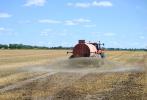H2020 RECAP Project: Customized public services to support the implementation of the CAP
- Type Project
- Status Filled
- Execution 2016 -2018
- Assigned Budget 2.142.381,75 €
- Scope Europeo
- Main source of financing Horizon 2020
- Project website RECAP
Public administrations responsible for implementing the Common Agricultural Policy (CAP) need to monitor farmers' compliance with the rules. Monitoring is carried out through field visits and remote sensing. Due to the high complexity and diversity of the obligations to be monitored, both methods have limitations and entail high costs for public administrations.
RECAP proposes a methodology to improve the efficiency and transparency of the compliance monitoring procedure through a cloud-based Software-as-a-Service (SaaS) platform that will utilize large volumes of public data provided by satellite remote sensing and user-generated data provided by farmers via mobile devices (georeferenced and time-stamped photographs). The RECAP platform will extract useful features from open Earth observation data, correlate them with user-generated and geoinformation data available to public organizations, and model this information to enable public authorities and inspectors to identify potential non-compliance.
RECAP will offer farmers a tool to help them comply with CAP regulations, providing them with personalized information to simplify the interpretation of complex regulations and early warnings of potential violations. RECAP will allow agricultural consultants and developers to create add-ons for the main application that extend its functionality and exploit the collected data through an application programming interface (API) and a software development kit (SDK). Consultants will be able to access the data available on the platform, subject to security and privacy policies, and develop their own services within the platform using design tools, libraries, and database communication under an open approach.
RECAP services will be tested and validated in an operational environment in five countries with the participation of public authorities, farmers, and agricultural consultants.
Making the Common Agricultural Policy easier to follow. The EU's Common Agricultural Policy (CAP) aims to support farmers while promoting the sustainable use of resources. It has shaped agriculture in the EU, and its vast scope, both geographically and in terms of the nature of its areas of application, sometimes makes it difficult to understand. An EU-funded project contributes to regulatory compliance. The RECAP project aims to help public administrations monitor farmers' compliance with CAP rules (Cross-Compliance and Greening) and enable them to comply with the regulations.
Dr. Machi Simeonidou, RECAP project coordinator at DRAXIS Environmental SA in Thessaloniki, explains: “The RECAP platform is the first solution that has attempted to build bridges between public administrations and farmers through the use of innovative Earth Observation (EO) solutions and cost-effective tools. The active participation of its users lays the foundation for the overall development of the RECAP platform, following the principle of “creating with users, for users.” The RECAP platform provides a data repository that can be used to guide farmers in complying with the regulations applicable to their farms. It also supports public authorities in monitoring and controlling farmers’ compliance. Farm characteristics and administrative information are entered into the platform for each farmer and translated into a personalized guide that identifies all the relevant regulations that the farmer must comply with in their particular situation.
Farmers become active players in the overall monitoring process. “This enables a transition to a guideline-based system that helps farmers understand and comply with CAP rules, rather than penalizing them for non-compliance,” says Dr. Simeonidou. For example, regarding greening rules and cross-compliance rules, specific instructions are provided to farmers, explaining in simple language what they should and shouldn't do to comply. A checklist is then created, and farmers can check off the actions taken and the instructions they followed. Based on the farmer's responses, each rule applicable to their farm is color-coded as completed or pending, helping them easily identify those still outstanding. So what data is it based on? Dr. Simeonidou explains that open satellite and other spatial data are combined, along with administrative data from public authorities and data generated by farmers and inspectors, to provide a comprehensive view. “Remote sensing results have been useful to agricultural advisors, allowing them to inform farmers about necessary corrections to erroneously declared plots, correct plot boundaries, and address any other errors that could cause potential non-compliance following inspection.” Validated results from the Remote Sensing (RS) component showed an overall crop type mapping accuracy of 80% to 90%, allowing for the identification of between 9 and 13 different types, depending on the case study. This covers more than 90% of the regional agricultural area.
It's a two-way street: farmers can not only identify their responsibilities but also upload information. Farmers can upload documents, along with geolocated and time-stamped photos (via a mobile app), to demonstrate their compliance with cross-compliance (CC) rules. The feedback received by the project shows that the majority of farmers participating in the pilot projects considered the most useful element of the RECAP platform to be receiving simple advice.
This platform adapts to each of the cross-compliance and greening rules applicable to each declared parcel. Inspectors using the platform estimated that its use reduced the time spent on each inspection by approximately one hour, and the use of RS contributes to an overall 25% reduction in the cost of on-site inspections.
- DRAXIS ENVIRONMENTAL SA (DRAXIS)







